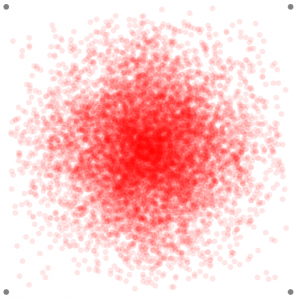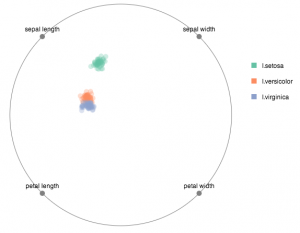Radviz high-dimensional visualization using paper.js

Many different approaches exist for visualizing points in high-dimensional space, including techniques such as multi-dimensional scaling and principal component analysis. Another popular option is parallel coordinates, but radviz is relatively less known. Although there are concerns about the fact that different points in multi-dimensional space can appear at the same position in the radviz visualization, it does have its uses. In the radviz approach, each dimension is represented as a point on a circle. The actual datapoints are then laid out within that circle such that the value in a particular dimension corresponds to the strength of an attraction force to the dimension-point on the circle.
Below is is the code for placing points in 4-dimensional space in radviz. Dimension anchors are in the four corners of a square, but just image them lying on a circle :-)
function Attractor(name, x, y) {
this.name = name
this.x = x
this.y = y
this.draw = function() {
var a = new Path.Circle(new Point(this.x, this.y),5);
a.fillColor = 'grey'
}
}
function DataPoint(attractions) {
this.attractions = attractions
this.forces = this.attractions.map(function(a) {return a.force})
this.totalAttractorForce = function() {
return this.attractions.map(function(a) {return a.force}).reduce(function(a,b) {return a+b})
}
this.coordinateX = function() {
return this.attractions.map(function(a) {return a.force*a.attractor.x}).reduce(function(a,b) {return a+b})/this.totalAttractorForce()
}
this.coordinateY = function() {
return this.attractions.map(function(a) {return a.force*a.attractor.y}).reduce(function(a,b) {return a+b})/this.totalAttractorForce()
}
this.coordinates = [this.coordinateX(),this.coordinateY()]
this.draw = function() {
var a = new Path.Circle(this.coordinates, 5)
a.fillColor = 'red'
a.opacity = 0.1
}
}
attractorA = new Attractor('A',50,50)
attractorB = new Attractor('B',550,50)
attractorC = new Attractor('C',50,550)
attractorD = new Attractor('D',550,550)
var attractors = [attractorA,attractorB,attractorC,attractorD]
attractors.map(function(a) {a.draw()})
for ( var i = 0; i < 10000; i++ ) {
var p = new DataPoint([{attractor:attractorA,force:Math.random()},
{attractor:attractorB,force:Math.random()},
{attractor:attractorC,force:Math.random()},
{attractor:attractorD,force:Math.random()}])
p.draw()
}A radviz representation of the Fisher’s Iris dataset:
